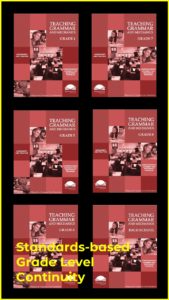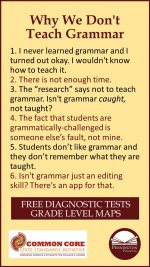Daily Paragraph Editing
Evan-More’s Daily Paragraph Editing is certainly an improvement over the publisher’s Daily Language Review or the popular Daily Oral Language (from many different publishers). The instructional scope and sequence of Daily Paragraph Editing is aligned to the Common Core State Standards and most other state Standards in grammar, usage, and mechanics. This being said, most of the same criticisms detailed in my previous article still apply. Editing in the context of a paragraph does not solve the issue of teaching skills in isolation. Requiring a student to write a similar article is not the same as requiring students to apply specific skills learned in a lesson in the context of their own writing.
Additionally, Daily Paragraph Editing really only tests students’ previously acquired skills. Testing is not the same as teaching. Direct instruction in the language conventions of grammar, usage, mechanics, and spelling is what the Common Core Language Strand authors envisioned, not endless practice without effective instruction.
Yes, kids need lots of practice, but we teachers need to remember what we learned in our teacher training programs about effective lesson design: Explicit Behavioral Objectives, Connection to Prior Learning and Lesson Transitions, Pre-teaching, Direct Instruction in the Content or Skill Standard with Multi-modality Examples and Language Support, Checking for Understanding, Guided Practice (which certainly could include some editing, but why not decision-making between what’s right and what’s wrong, instead of error-only scavenger hunts?), Formative Assessment, Re-teaching, Individualized Instruction, and Independent Practice. Of course, teachers are accustomed to different names for the essentially the same lesson components. Essentially, the teacher uses comprehensible input to introduce new learning, the students practice with the teacher’s help, the teacher assesses students’ mastery of the lesson content and skills and uses the data to re-teach or individualize instruction, and assigns independent practice in which the students’ apply what they have learned. Basic lesson design.
The Daily Paragraph Editing program suffers from the same false assumptions that some teachers, administrators, and parents frequently share: All students are alike and need the same instruction. We know better. Kids are snowflakes: each is different and has different needs and different levels of content and skills mastery, particularly in the disciplines of the Language Strand: grammar, usage, mechanics, spelling, vocabulary, and knowledge of use.
A cookie-cutter approach to instruction such as Daily Paragraph Editing, Daily Oral Language, and Daily Language Review winds up re-teaching what some students already know (a waste of time), not building upon previous grade-level instruction, and short-changing instruction for those students, such as our ELL, Special Education, and below grade level students who need assessment-based practice. Students need effectively designed grade-level instruction, using all of the elements of direct instruction; plus, they need assessment-based individualized instruction for additional remedial practice so they can “catch up” while they “keep up” with rigorous writing instruction.
Teaching that helps students actually learn and retain skills and concepts requires something more than just a writing opener used only a few minutes each day. We teachers can do better than piecemeal and ineffective instruction. Good teachers don’t just want to address Standards, they want their students to learn, retain, and be able to apply them in the reading and writing contexts.
Bottom line? The Daily Paragraph Editing program is a short-cut to “teach” Language Strand Standards that can’t possibly transfer to long term content and skills acquisition. It has many of the same issues as Daily Language Review and Daily Oral Language. Teachers wind up “teaching” the same content and skills year after year. Clearly, we have better alternatives for effective instruction in the the Language Strand Standards.
Here is the most effective alternative…
*****

Pennington Publishing Grammar Programs
Teaching Grammar, Usage, and Mechanics (Grades 4, 5, 6, 7, 8, and High School) are full-year, traditional, grade-level grammar, usage, and mechanics programs with plenty of remedial practice to help students catch up while they keep up with grade-level standards. Twice-per-week, 30-minute, no prep lessons in print or interactive Google slides with a fun secret agent theme. Simple sentence diagrams, mentor texts, video lessons, sentence dictations. Plenty of practice in the writing context. Includes biweekly tests and a final exam.
Grammar, Usage, and Mechanics Interactive Notebook (Grades 4‒8) is a full-year, no prep interactive notebook without all the mess. Twice-per-week, 30-minute, no prep grammar, usage, and mechanics lessons, formatted in Cornell Notes with cartoon response, writing application, 3D graphic organizers (easy cut and paste foldables), and great resource links. No need to create a teacher INB for student make-up work—it’s done for you! Plus, get remedial worksheets, biweekly tests, and a final exam.
Syntax in Reading and Writing is a function-based, sentence level syntax program, designed to build reading comprehension and increase writing sophistication. The 18 parts of speech, phrases, and clauses lessons are each leveled from basic (elementary) to advanced (middle and high school) and feature 5 lesson components (10–15 minutes each): 1. Learn It! 2. Identify It! 3. Explain It! (analysis of challenging sentences) 4. Revise It! (kernel sentences, sentence expansion, syntactic manipulation) 5. Create It! (Short writing application with the syntactic focus in different genre).
Get the Diagnostic Grammar, Usage, and Mechanics Assessments, Matrix, and Final Exam FREE Resource:
![]()
Get the Grammar and Mechanics Grades 4-8 Instructional Scope and Sequence FREE Resource:
![]()
Grammar/Mechanics, Literacy Centers, Spelling/Vocabulary, Study Skills, Writing
 I hear the same two comments at English-language arts conferences all the time:
I hear the same two comments at English-language arts conferences all the time: 
